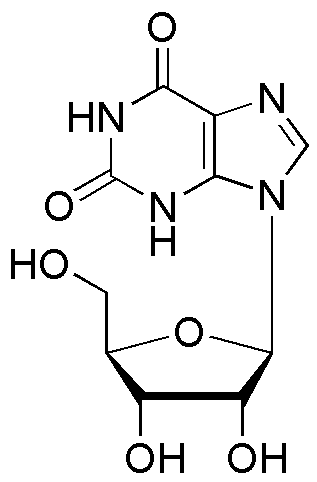Xanthosine is widely utilized in research focused on:
- Nucleotide Research: It serves as a key building block in the study of nucleotides, helping researchers understand genetic material and its functions.
- Biochemical Pathways: Xanthosine is important in exploring purine metabolism, aiding in the development of treatments for metabolic disorders.
- Pharmaceutical Development: Its derivatives are investigated for potential therapeutic applications, particularly in antiviral and anticancer drugs.
- Cell Culture Studies: It is used in cell culture media to promote cell growth and viability, essential for various biological experiments.
- Diagnostic Tools: Xanthosine levels can be measured in biological samples, assisting in the diagnosis of certain diseases and conditions.
Informations générales
Propriétés
Sécurité et réglementation
Applications
Xanthosine is widely utilized in research focused on:
- Nucleotide Research: It serves as a key building block in the study of nucleotides, helping researchers understand genetic material and its functions.
- Biochemical Pathways: Xanthosine is important in exploring purine metabolism, aiding in the development of treatments for metabolic disorders.
- Pharmaceutical Development: Its derivatives are investigated for potential therapeutic applications, particularly in antiviral and anticancer drugs.
- Cell Culture Studies: It is used in cell culture media to promote cell growth and viability, essential for various biological experiments.
- Diagnostic Tools: Xanthosine levels can be measured in biological samples, assisting in the diagnosis of certain diseases and conditions.
Documents
Fiches de données de sécurité (FDS)
La FDS fournit des informations de sécurité complètes sur la manipulation, le stockage et l’élimination du produit.
Spécifications du produit (PS)
Le PS fournit une description complète des propriétés du produit, notamment sa composition chimique, son état physique, sa pureté et les exigences de stockage. Il détaille également les plages de qualité acceptables et les applications prévues du produit.
Certificats d'analyse (COA)
Recherchez des certificats d'analyse (COA) en saisissant le numéro de lot du produit. Les numéros de lot et de lot se trouvent sur l'étiquette d'un produit, après les mots « Lot » ou « Lot de fabrication ».
Numéro de catalogue
Numéro de lot/série
Certificats d'origine (COO)
Ce certificat d'exploitation confirme le pays dans lequel le produit a été fabriqué, et détaille également les matériaux et composants utilisés et s'il est issu de sources naturelles, synthétiques ou autres sources spécifiques. Ce certificat peut être requis pour les douanes, le commerce et la conformité réglementaire.
Numéro de catalogue
Numéro de lot/série
Fiches de données de sécurité (FDS)
La FDS fournit des informations de sécurité complètes sur la manipulation, le stockage et l’élimination du produit.
DownloadSpécifications du produit (PS)
Le PS fournit une description complète des propriétés du produit, notamment sa composition chimique, son état physique, sa pureté et les exigences de stockage. Il détaille également les plages de qualité acceptables et les applications prévues du produit.
DownloadCertificats d'analyse (COA)
Recherchez des certificats d'analyse (COA) en saisissant le numéro de lot du produit. Les numéros de lot et de lot se trouvent sur l'étiquette d'un produit, après les mots « Lot » ou « Lot de fabrication ».
Numéro de catalogue
Numéro de lot/série
Certificats d'origine (COO)
Ce certificat d'exploitation confirme le pays dans lequel le produit a été fabriqué, et détaille également les matériaux et composants utilisés et s'il est issu de sources naturelles, synthétiques ou autres sources spécifiques. Ce certificat peut être requis pour les douanes, le commerce et la conformité réglementaire.


